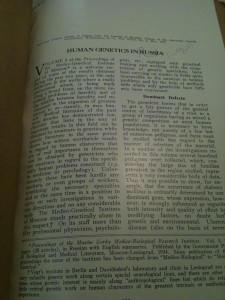 Two weeks ago, when we posted about the Lysenko Controversy in Soviet Russia, mention was made of Geoffrey Beale’s interest in and knowledge of the Russian language and scientific history. Beale was based at the Institute of Animal Genetics in Edinburgh from 1947 until 1978 and is best known as the founder of malaria genetics. His personal archive, which takes up some 40 boxes and contains notebooks, correspondence, publications and drafts, is currently being catalogued here in Edinburgh University Library Special Collections, so a brief biography may be in order to shed some light on this humane and fascinating man.
Two weeks ago, when we posted about the Lysenko Controversy in Soviet Russia, mention was made of Geoffrey Beale’s interest in and knowledge of the Russian language and scientific history. Beale was based at the Institute of Animal Genetics in Edinburgh from 1947 until 1978 and is best known as the founder of malaria genetics. His personal archive, which takes up some 40 boxes and contains notebooks, correspondence, publications and drafts, is currently being catalogued here in Edinburgh University Library Special Collections, so a brief biography may be in order to shed some light on this humane and fascinating man.
Beale, born in Wandsworth, London in 1913, developed a keen interest in Botany while a student in Imperial College, London, despite his parents’ opposition to a scientific career (he was even made to sit a psychological examination which recommended that he become a tax inspector instead!). In his third year of university, Beale completed a summer course in plant genetics given at the John Innes Horticultural Institute, which would shape the course of his future career. Beale was eventually offered a job at the John Innes, receiving his PhD in 1938 and studying, among other things, the chemistry of flower colour variation until being called up to the army in 1941.
Due to having what he called a ‘smattering’ of languages, including Russian, Beale was drafted into the Intelligence Corps (Field Security) and posted to Archangel and then Murmansk, Russia, where he had the opportunity to improve his Russian. Beale was awarded an MBE for his military service in 1947.
After the war, Beale wondered how he would get back into science after his five year absence. Fortunately, he was offered a job at Cold Spring Harbor working with Escherichia coli. Beale also worked for a spell with geneticist Tracy Sonneborn at Bloomington, Indiana, and it was then Beale developed his lifelong interest in the protozoan Paramecium. The award of a Rockefeller Fellowship necessitated his return to the UK in 1947, where he was duly offered a lectureship by C.H. Waddington, who had just arrived in Edinburgh as director of the genetics section of the National Animal and Genetics Research Organisation within the Institute of Animal Genetics. At the Institute, Beale became close friends with Henrik Kacser and Charlotte ‘Lotte’ Auerbach, about whom he would later write an account, and gained funding to design and build dedicated research laboratories, including the Protozoan Genetics building for his research group. This group worked on the genetics of Paramecium and on protozoan parasites, and attracted visiting scientists from all over the world. Beale was appointed a Royal Society Research Professor in 1963, a position he held until his retirement.
In the mid-1960s, Beale developed an interest in malaria genetics, gaining a grant from the Medical Research Council in 1966. Together with programme leader David Walliker, who would become a renowned malariologist, they established a mosquito colony, built an insectary, collected parasite strains and established rodent facilities for African tree rats. The work of another researcher, Richard Carter, helped establish the parasite genetic markers, and the foundations of genetic analysis in malaria parasites were laid. Later research covered the genetic analysis of drug resistance, virulence and the classification of rodent malarias into species and subspecies. He continued his malaria work during a six month visiting professorship at Chulalongkorn University in Bangkok, establishing a collaborative research programme with Professor Sodsri Thaithong as well as a malaria research laboratory which achieved World Health Organisation Collaborating Centre status. This phase of Beale’s career laid the groundwork for many other scientists working on parasite diversity and genetics. In 1996 Beale was awarded an honorary DSc from Chulalongkorn University, one of the first foreigners to be so honoured.
Beale married Betty MacCallum in 1949 (they were divorced in 1969) and he would often take their three sons to the laboratory with him on Sundays where they would learn about science and film printing techniques. Beale continued to work at the laboratory every day well after his retirement. After 1998 he began work on a new book on Paramecium to show the advances and new directions of research in the area. However, his health was deteriorating and much of the later writing was done by co-author John Preer. The book, Paramecium: Genetics and Epigenetics, was published in 2008, when Beale was 95 years old. Geoffrey Beale died in Edinburgh on 16 October 2009.
We’ll be posting up items of interest from the Beale collection as cataloguing progresses, with the finished catalogue being mounted online on our newly-launched project website at: http://www.archives.lib.ed.ac.uk/towardsdolly/
References:
J. R. Preer Jr and Andrew Tait, ‘Geoffrey Herbert Beale MBE’, Biographical Memoirs of Fellows of the Royal Society, 57: 45-62 (2011)
Geoffrey Beale, ‘Autobiograpy (written July 1997)’, in Coll-1255, EUL Special Collections.




